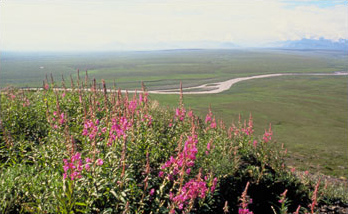Gelisol
In the World Reference Base for Soil Resources[1] (WRB), most Gelisols belong to the Cryosols.Despite the influence of glaciation in most areas where Gelisols occur, chemically they are not highly fertile because nutrients, especially calcium and potassium, are very easily leached above the permafrost.The permafrost greatly restricts the engineering use of Gelisols, as large structures (e.g. buildings) subside as the frozen earth thaws when they are put in place.Smaller areas are found in the Andes (mainly near the intersection between Chile, Bolivia and Argentina), Tibet, northern Scandinavia and the ice-free parts of Greenland and Antarctica.Fossil Gelisols are known from as far back as Precambrian ice ages 900 million years ago.


USDA soil taxonomyProfilecryoturbationsubarctictundrapermafrostWorld Reference Base for Soil ResourcesHistosolsB horizonA horizonsoil organic mattersoil colorglaciationnutrientscalciumpotassiumSiberiaAlaskaCanadaBoliviaArgentinaScandinaviaGreenlandAntarcticaFossilPrecambrianparalithiccontinuous permafrostdiscontinuous permafrostActive layerPedogenesisPedology (soil study)Soil classificationAcrisolsAlisolsAndosolsAnthrosolsArenosolsCalcisolsCambisolsChernozemCryosolsDurisolsFerralsolsFluvisolsGleysolsGypsisolsHistosolKastanozemsLeptosolsLixisolsLuvisolsNitisolsPhaeozemsPlanosolsPlinthosolsPodzolsRegosolsRetisolsSolonchaksSolonetzStagnosolTechnosolsUmbrisolsVertisolsAlfisolsAndisolsAridisolsEntisolsInceptisolsMollisolsOxisolsSpodosolsUltisolsFAO soil classificationUnified Soil Classification SystemAASHTO Soil Classification SystemRéférentiel pédologiqueCanadian system of soil classificationAustralian Soil ClassificationPolish Soil Classification1938 USDA soil taxonomyList of U.S. state soilsList of vineyard soil typesTopsoilSubsoilSoil crustClaypanHardpanGypcrustCalicheParent materialPedosphereLaimosphereRhizosphereBulk soilAlkali soilBay mudBlue gooBrickearthBrown earthCalcareous grasslandDark earthDry quicksandDuplex soilEluviumExpansive clayFill dirtFuller's earthHydrophobic soilLunar soilMartian soilMuskegPaleosolPrime farmlandQuicksandSerpentine soilSpodic soilStagnogleySubaqueous soilTerra pretaTerra rossaTropical peatYedoma